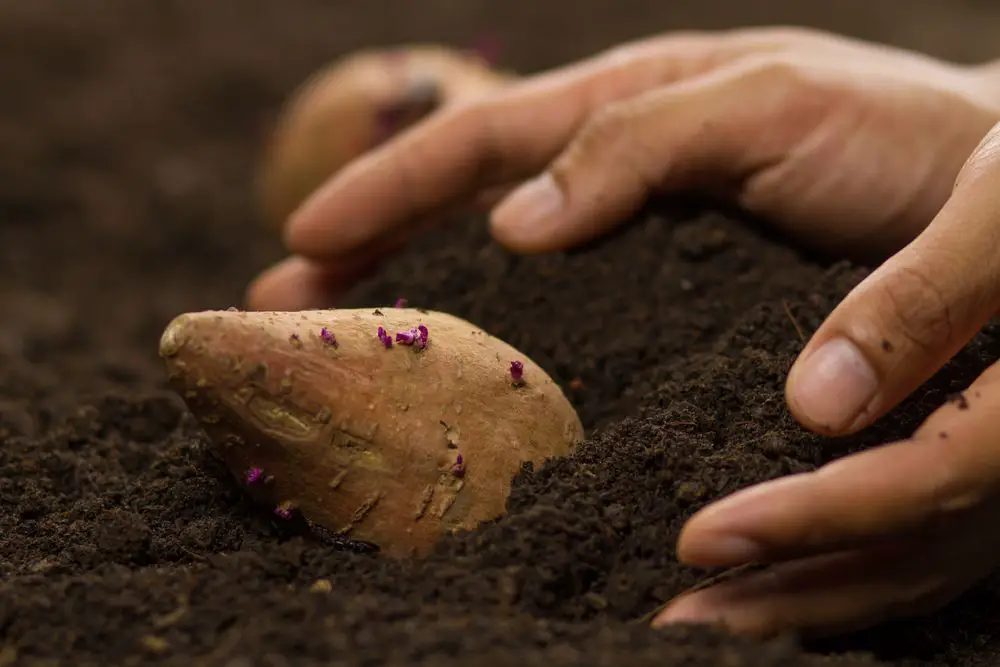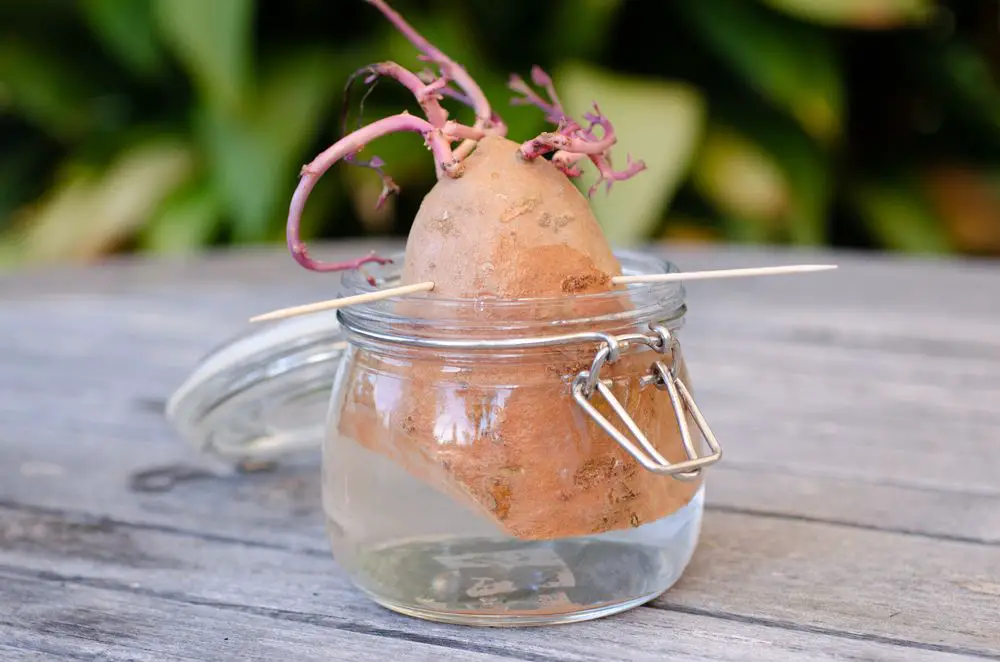You may be surprised to know that sweet potatoes are grown from slips and not from seeds. It’s up to you to decide to buy sweet potato slips or grow your own.
Sweet Potato Slips are made by putting them in water to grow roots or putting them in the earth for the same reason. With a sweet potato, a jar with water, some scissors and toothpicks – it’s amazing what you can do! The trailing vines and roots together with the colorful blooms are a re-assuring sight that exciting things are happening
How to Make Sweet Potato Slips
Sweet potatoes are roots (unlike potatoes which are tubers), so they’re propagated through a slip. A slip is a sweet potato sprout.
Let’s explain further:
Growing your sweet potatoes is inexpensive, easy, and fun, especially when starting from your own sweet potato slips.
You just cannot cut up sweet potatoes into pieces and plant them into the ground. You should first allow green shoots to form from a whole sweet potato.
The tiny plants (slips) are needed to grow sweet potatoes in your garden.
One sweet potato can make about 15 or more sweet potato slips.
Fifteen slips mean you have 15 plants with about 60 sweet potatoes possibly harvest.
There are a few methods to make sweet potato slips – in dirt or water. Making slips in dirt, though, is a quicker method.
If you intend to use sweet potato from the store, choose organic.
This sweet potato is less likely to have been exposed to chemicals. Make sure, too, that the sweet potato is not bruised or does not have any visible damage.
You can make your sweet potato slips on your windowsill or kitchen.
Method 1: Making Sweet Potato Slips in Water
What you need:
- (1) Sweet Potato
- Water
- (1) Cup or Jar wide enough to fit a sweet potato
- Toothpicks
- Scissors
- A warm spot
What you need to do:
- Make sure the sweet potato will fit into the cup or Mason jar you intend to use. You can use a whole sweet potato and cut them into half to make two sets
of sweet potato slips. Using cut ends tends to speed up the sprouting process. - Press four pieces of toothpick and press them into the sweet potato. Your goal is to make a ring halfway down around the potato.
- Place the sweet potato into the cup or jar.
- Fill the cup or jar with water. Make sure water is about ½ inch below the toothpicks. Submerging the toothpicks will cause spillage and possible rotting.Also, make sure that about ½ of the sweet potato is not submerged in water.
- Place your cup or jar in the sunniest or warmest spot in your house. A well-lit room near a radiator or a sunny window is your best option.Sweet potatoes thrive when temperatures are over 80 degrees. A warm spot will allow slips to grow faster and produce more slips.
- Make sure always to check the water level of your cup or jar. The Lower half of the sweet potato should always be underwater. Check if the water is getting cloudy. If it is, pour out the water and refill your cup or jar with fresh water. You also need to check if portions of your sweet potato show signs of rotting. If this happens, you need to discard the set.
- In a few weeks, you will see the appearance of sweet potato slips. A few roots will first develop below the water. Stems and foliage will then begin to sprout from the top.
- Cut them at the base when the sweet potato slips are about 6 inches long or more.
- Place the slips in a small cup with water and wait until their roots appear and grow to be 2 to 3 inches long.
- Remove the bottom third of the leaves and plant the slips into the ground.
Your original sweet potato will keep developing new slips on the spot where the old slips developed. Therefore, you can create several sets of slips before you are ready to plant them onto the ground.
June and July are the best times to start planting your sweet potato slips.
Method 2: Making Sweet Potato Slips in Dirt

What you need:
- (1) Sweet Potato or more
- A flower pot deep enough to bury your sweet potato
- Soil
What you need to do:
- If you are using more than one sweet potato, make sure your pot is deep enough to allow 3-4 inches of space between the sweet potatoes. It should also bedeep enough to cover all the sweet potatoes.
- Add soil to the bottom of your flower pot.
- Place the sweet potatoes in the pot. Make sure they are at least 2 to 3 inches apart.
- Cover the sweet potatoes with 1 to 2 inches of soil.
- Place your flower pot in the sunniest and warmest place in your home.
- Check on your sweet potatoes every 2 to 3 days. The soil should always be moist but not soppy. Water only as needed. Overwatering will make your
sweet potato rot. - Sweet potato sprouts will appear within a few weeks.
- Cut off the sprouts, which appear at soil level when about six inches long. This happens after about a month or so.
- Place the sprouts in a cup of water and allow the roots to appear and grow to be about 2 to 3 inches long.
- Plant the sweet potato slips into the soil. Make sure to take off the bottom third of the leaves.
The earlier you plant your sweet potato slips, the better. June and July are the ideal months. Water your sweet potato regularly during the first week.
Leave the mother plant when you harvest your sweet potatoes so they can continue to make sweet potato slips in the coming weeks.
What is a Sweet Potato Slip?
Sweet potatoes come from the Convolvulaceae family. They are grown and consumed because they are rich in nutrients. They are also attractive plants in your garden because of their colorful blooms and trailing vines.
Potatoes and sweet potatoes (Ipomoea batatas) come from different families. As such, they have other methods of propagation.
Potatoes are tubers grown from seeds. Regular potato seeds are a portion of the tuber with at least one bud or “eye.” The eye sprouts leaf and stem when planted in soil.
Sweet potatoes are root crops grown from slips or sweet potato sprouts. Therefore, a sweet potato slip is a sprout that forms from a sweet potato.
Sweet potato slips are pieces of stems that have some leaves coming from a mother root. They do not come from seeds or replanted roots.
You can make sweet potato slips by enticing a rooted sprout of a mature sweet potato to propagate. How is this done?
Final Thoughts on How to Make Sweet Potato Slips
Sweet potatoes are popular today more than ever. They are good sources of vitamins and fiber.
They are a healthy choice because they have a lower sugar index than the more popular white potatoes.
Along with the new popularity of sweet potatoes, so has the interest in growing them in many home gardens. Even novice gardeners can easily plant, grow, and harvest sweet potatoes.
Whether you choose to make sweet potato slips in water or dirt, the key consideration is never to rush planting the slips into your garden. The soil and weather need to be warm – ideally about a few weeks after the last expected spring frost.
If you are in a rush to plant your sweet potato slips, install a tunnel or anything over the garden bed to provide shelter for the slips.
By the way, you can also opt to buy sweet potato slips. But it’s so much more fun and infinitely more rewarding to grow your own!
Some of us have also started with our slips and probably have just enough patience to wait the necessary six weeks
Jenny Marie
Tribal Writer
Edited By
Patricia Godwin

